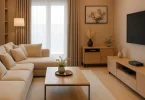The layout of your living room furniture plays a crucial role in how comfortable and functional the space feels. A well-planned living room furniture layout not only enhances the flow of the room but also sets the tone for relaxation, conversation, and entertainment. Whether your living space is small, large, open-concept, or oddly shaped, the right arrangement can transform it into a perfect blend of style and comfort.
Basics of Living Room Furniture Layout
Before arranging furniture, it’s important to understand the purpose of your living room. Is it meant for entertaining guests, watching TV, or relaxing with family? Once the function is clear, you can decide on the main focal point and arrange furniture around it for maximum comfort and harmony.

Key Elements to Consider
- Room Size and Shape: Measure the dimensions and note any architectural features like windows, doors, or fireplaces.
- Focal Point: This could be a TV, fireplace, artwork, or large window.
- Traffic Flow: Ensure pathways remain clear and accessible.
- Balance and Symmetry: Distribute furniture evenly to avoid crowding one side.
Common Living Room Furniture Layout Types
Symmetrical Layout
This layout is ideal for formal living rooms. It involves placing matching furniture pieces on either side of a central focal point, creating a balanced and harmonious look.
- Example: Two sofas facing each other with a coffee table in between.
- Works best in square or rectangular rooms.
Asymmetrical Layout
Perfect for casual or modern spaces, an asymmetrical living room furniture layout focuses on visual balance rather than identical placement.
- Example: A sectional sofa paired with two mismatched chairs.
- Great for open-plan homes or small apartments.
L-Shaped Layout
An L-shaped arrangement is practical and cozy, especially for small or medium-sized rooms. It defines space without overcrowding and is ideal for TV viewing or conversation areas.
- Example: A sectional sofa forming an L shape with a coffee table in the center.
U-Shaped Layout
This layout promotes togetherness and is great for large families or gatherings. It surrounds the focal point on three sides, creating an inviting seating area.
- Example: A large sofa flanked by two armchairs or a combination of sectional and chairs.
Floating Furniture Layout
Instead of pushing furniture against walls, this layout involves placing seating toward the center of the room. It creates a cozy and intimate vibe.
- Works especially well in open-concept spaces.
- Add rugs to define the area and anchor the furniture.
You may also like to read these posts:
Easy DIY Home Decor Ideas to Transform Your Space
Wooden Furniture Trends Today: What’s Hot in 2025
Minimalist Furniture Design Trend 2025
Smart Furniture Ideas for Modern Homes
How to Choose the Right Furniture for Your Layout
Selecting the right furniture pieces is as important as their placement. Each item should complement the room’s dimensions and function while maintaining a cohesive design.
Tips for Choosing Furniture
- Scale and Proportion: Avoid oversized furniture in small rooms.
- Multifunctional Pieces: Use ottomans, nesting tables, or sofa beds for flexibility.
- Comfort First: Prioritize comfortable seating over decorative elements.
- Matching Styles: Keep the design theme consistent—modern, minimalist, or traditional.
Balancing Functionality and Aesthetics
An effective living room furniture layout must balance beauty and practicality. This can be achieved by organizing pieces based on their purpose while keeping the overall design visually appealing.

Functional Tips
- Place sofas and chairs to encourage conversation.
- Keep the coffee table within easy reach of all seating.
- Allow at least 18 inches of space between furniture pieces.
- Use rugs to define zones in open-plan layouts.
Designing for Small Living Rooms
In smaller spaces, every inch matters. Smart furniture arrangement can make a compact living room appear larger and more open.
Small Space Layout Tips
- Use wall-mounted shelves instead of bulky cabinets.
- Choose light-colored furniture to enhance space perception.
- Keep furniture legs exposed to maintain visual openness.
- Use mirrors to reflect light and make the room appear bigger.
Living Room Furniture Layout for Open-Concept Spaces
Open-plan layouts combine the living, dining, and kitchen areas. To maintain order, zoning becomes essential.
Zoning Ideas
- Use rugs to separate living and dining zones.
- Arrange furniture in groupings that define each function.
- Maintain consistent color palettes across open areas.
- Use low-profile furniture to avoid blocking sightlines.
Ideal Lighting Arrangement for a Balanced Layout
Lighting enhances the overall ambiance and highlights the furniture arrangement. Combine different lighting types for a complete look.
Lighting Tips
- Use overhead lighting for general illumination.
- Add table or floor lamps near seating for reading or mood lighting.
- Consider accent lighting to highlight wall art or architectural details.
- Dimmer switches allow flexibility for different activities.
Decorating Around Your Furniture Layout
Accessories and decor complete the look of your living room furniture layout. However, they should not clutter the space.
Decoration Guidelines
- Add one or two statement pieces like art or a large plant.
- Keep side tables simple and functional.
- Use soft furnishings such as throw pillows and blankets for texture.
- Maintain visual balance by distributing decor evenly.
Common Mistakes to Avoid
Even the best furniture can look misplaced if not arranged properly. Avoiding these common mistakes ensures a harmonious design.
Mistakes to Watch Out For
- Pushing all furniture against walls.
- Blocking windows or walkways.
- Using mismatched scales (oversized sofa with tiny table).
- Ignoring lighting or rug placement.
Final Tips for the Perfect Living Room Furniture Layout
- Test different arrangements before finalizing.
- Take photos from various angles to check proportions.
- Add plants for a touch of freshness.
- Keep clutter minimal to maintain flow and comfort.
Frequently Asked Questions (FAQs)
How do I start planning my living room furniture layout?
Start by identifying the room’s purpose and focal point, then arrange furniture around it while ensuring clear walkways.
What is the best furniture layout for small living rooms?
An L-shaped or floating furniture layout works best for small spaces as it maximizes seating while maintaining openness.
How can I make my living room layout more functional?
Use multipurpose furniture, maintain good lighting, and ensure that every item serves a practical role.
Should I place furniture against the wall?
Not necessarily. Floating furniture away from walls can make a room look more dynamic and intimate.
How do rugs affect furniture layout?
Rugs define seating zones and anchor furniture, helping maintain visual order in both small and open-plan spaces.
Conclusion
Designing the right living room furniture layout is all about understanding your space, purpose, and personal style. A well-thought-out layout enhances functionality, aesthetics, and comfort, turning your living room into the true heart of your home. Whether you prefer a formal symmetrical setup or a relaxed open plan, the key is to create a space that feels balanced, inviting, and uniquely yours.






